An Investigation of ANZ Company's Management Issues and Solutions
VerifiedAdded on 2023/04/11
|12
|2656
|194
Report
AI Summary
This report examines the contemporary management issues faced by the Australia and New Zealand Banking Group Limited (ANZ) Company, focusing on organizational culture and poor leadership as primary challenges. The analysis delves into how these issues, including inconsistencies in strategic planning, conflicts between the chain of command and influence, employee retention problems, internal competition, and a discouraging bureaucratic culture, impact the company's performance. Furthermore, the report explores the consequences of poor leadership, such as demotivation, lack of employee initiative, and underutilization of staff. The study then highlights the application of contemporary management tools, specifically strategic planning, benchmarking, and training, as potential solutions to address these challenges and improve the company's overall performance and employee engagement. The report emphasizes the importance of clear mission, vision, and values; achievable goals; and effective leadership to foster a positive work environment and enhance organizational success.
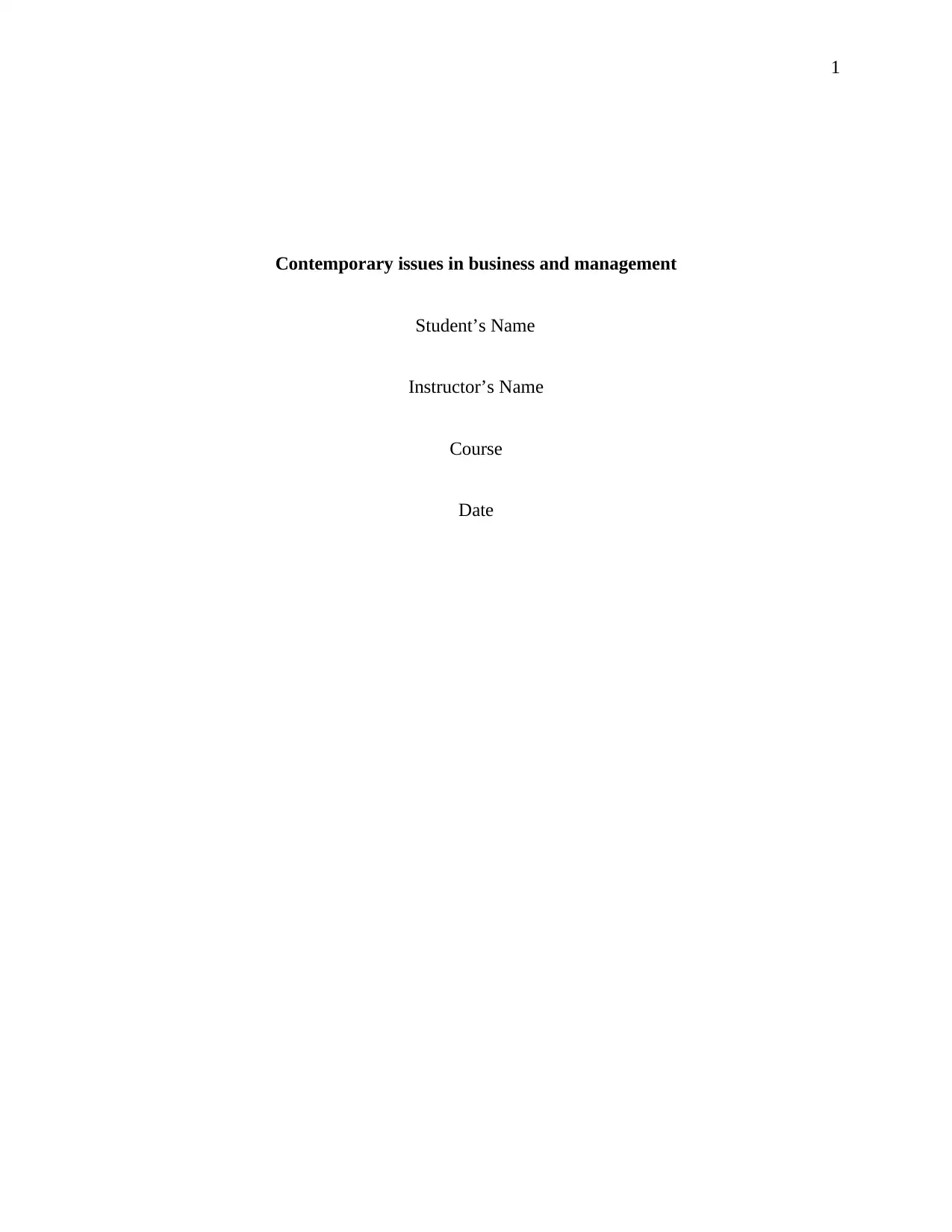
1
Contemporary issues in business and management
Student’s Name
Instructor’s Name
Course
Date
Contemporary issues in business and management
Student’s Name
Instructor’s Name
Course
Date
Paraphrase This Document
Need a fresh take? Get an instant paraphrase of this document with our AI Paraphraser

2
Introduction
Contemporary management issues examine the way organizational reacts to address
various emerging issues in an organization. Management issues are dominant in most of the
organizations as a result of current and past practices. Furthermore, the contemporary business
environment is very competitive with diverse organizations imposing high quality of human
resource to survive the rapid competition. However, management of the human resource has
remained to be the main challenge to various organizations. The challenges have been a key
determinant of variation that exists between the diverse organization in terms of performances,
market shares and profit margins. Due to the tough management challenges, many organizations
have identified the management issues and strategized on their solutions. Therefore, the paper
seeks to identify key management issues arising from ANZ Company’s planning, organizing,
leading or controlling process, the impact of the issues on business performance and
contemporary management tools to address the issues.
Brief introduction of ANZ Company
Australia and New Zealand Banking Group Limited (ANZ) Company is one the leading
financial institution in Singapore. The company was founded as a representative office of New
Zealand and Australia Banking group in 1974 (Australia and New Zealand Banking Group
Limited, 2019). The financial institution was later converted to an offshore bank in 1980 and
upgraded to the wholesale bank in 2002. In Singapore, ANZ Company offers an integrated
solution of corporate banking and institutional, retail banking, financial markets, investment
banking services, private banking and trade finance.
Introduction
Contemporary management issues examine the way organizational reacts to address
various emerging issues in an organization. Management issues are dominant in most of the
organizations as a result of current and past practices. Furthermore, the contemporary business
environment is very competitive with diverse organizations imposing high quality of human
resource to survive the rapid competition. However, management of the human resource has
remained to be the main challenge to various organizations. The challenges have been a key
determinant of variation that exists between the diverse organization in terms of performances,
market shares and profit margins. Due to the tough management challenges, many organizations
have identified the management issues and strategized on their solutions. Therefore, the paper
seeks to identify key management issues arising from ANZ Company’s planning, organizing,
leading or controlling process, the impact of the issues on business performance and
contemporary management tools to address the issues.
Brief introduction of ANZ Company
Australia and New Zealand Banking Group Limited (ANZ) Company is one the leading
financial institution in Singapore. The company was founded as a representative office of New
Zealand and Australia Banking group in 1974 (Australia and New Zealand Banking Group
Limited, 2019). The financial institution was later converted to an offshore bank in 1980 and
upgraded to the wholesale bank in 2002. In Singapore, ANZ Company offers an integrated
solution of corporate banking and institutional, retail banking, financial markets, investment
banking services, private banking and trade finance.

3
Key contemporary issues arising from Australia and New Zealand Banking Group Limited
Currently, ANZ Company has experienced diverse management issues that have
significantly slowed down the growth and development of the company. Currently, the key
management issues faced by the company include; organizational culture, allocation of human
resource, poor leadership, poor planning, retentions, workforce conflicts, low employee
engagement, the poor commitment of key staff, change management issues and relationships
with customer care. However, the two main contemporary management issues faced by the
company include organizational culture and poor governance or leadership.
Currently, Organizational culture has emerged to be the current management issues faced
by ANZ Company. Furthermore, the organization culture of the company has significantly
influenced the four functions of management (planning, leading, organizing and controlling)
leading to poor performance, the decline in market shares and low turnovers. According to Wei,
Samiee and Lee (2014 p.49), organizational culture is underlying values, beliefs, assumptions
and the ways of interacting that lead to the unique psychological and social environment of an
organization. Furthermore, organizational culture in an organization may include experiences,
expectations, values and philosophies that guide behaviors of members and is expressed in
member’s self-image, future expectation and interaction of workforces.
ANZ is also facing a contemporary issue of leadership with some departmental leaders
and supervisors failing to deliver effective services to workforces and customers. Poor leadership
in the company has significantly spoiled the reputation of the company and interfered with
operations and performances. According to Rouse (2009 p.463), poor leadership is inability of a
leader to inspire others, motivate performances and create sustainable value. Further research
Key contemporary issues arising from Australia and New Zealand Banking Group Limited
Currently, ANZ Company has experienced diverse management issues that have
significantly slowed down the growth and development of the company. Currently, the key
management issues faced by the company include; organizational culture, allocation of human
resource, poor leadership, poor planning, retentions, workforce conflicts, low employee
engagement, the poor commitment of key staff, change management issues and relationships
with customer care. However, the two main contemporary management issues faced by the
company include organizational culture and poor governance or leadership.
Currently, Organizational culture has emerged to be the current management issues faced
by ANZ Company. Furthermore, the organization culture of the company has significantly
influenced the four functions of management (planning, leading, organizing and controlling)
leading to poor performance, the decline in market shares and low turnovers. According to Wei,
Samiee and Lee (2014 p.49), organizational culture is underlying values, beliefs, assumptions
and the ways of interacting that lead to the unique psychological and social environment of an
organization. Furthermore, organizational culture in an organization may include experiences,
expectations, values and philosophies that guide behaviors of members and is expressed in
member’s self-image, future expectation and interaction of workforces.
ANZ is also facing a contemporary issue of leadership with some departmental leaders
and supervisors failing to deliver effective services to workforces and customers. Poor leadership
in the company has significantly spoiled the reputation of the company and interfered with
operations and performances. According to Rouse (2009 p.463), poor leadership is inability of a
leader to inspire others, motivate performances and create sustainable value. Further research
⊘ This is a preview!⊘
Do you want full access?
Subscribe today to unlock all pages.

Trusted by 1+ million students worldwide
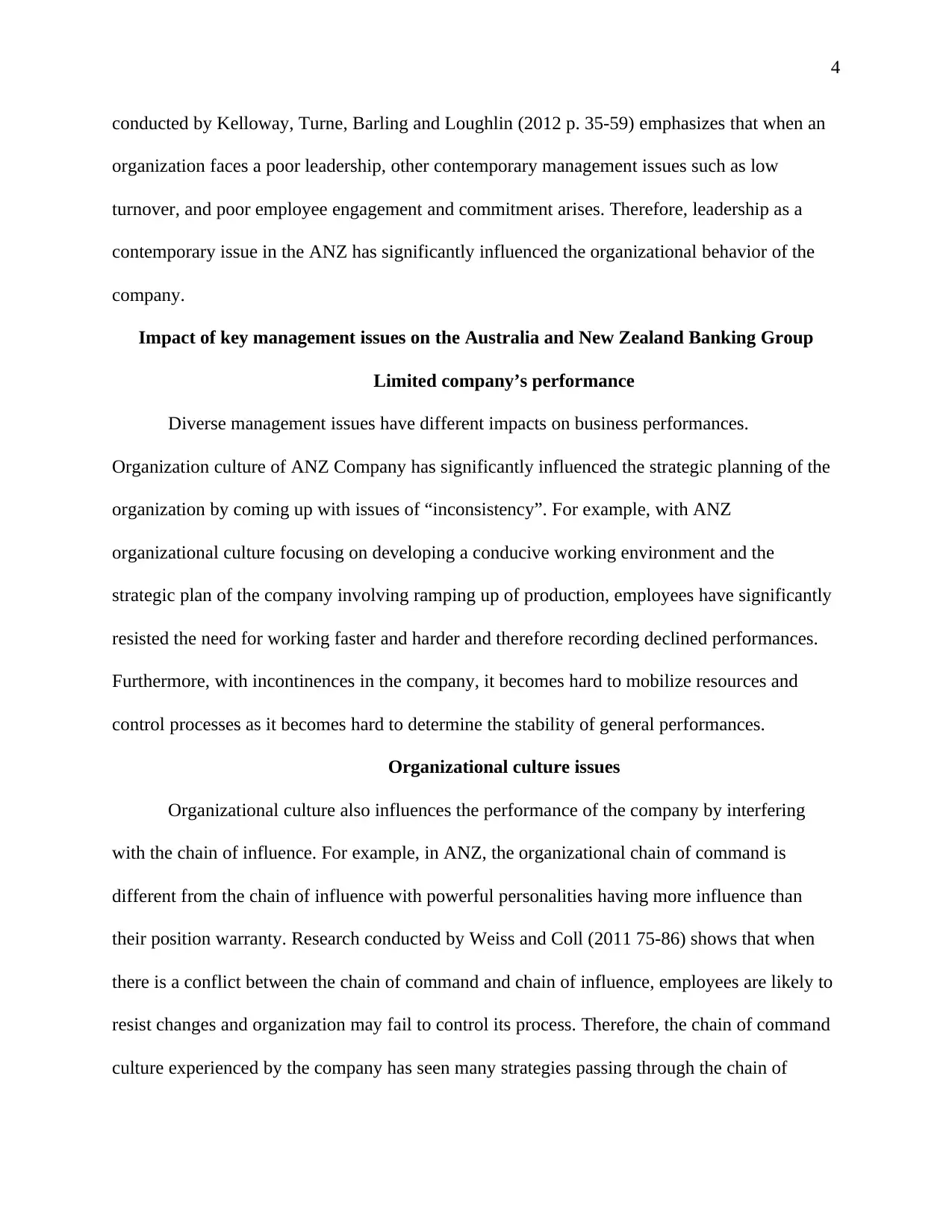
4
conducted by Kelloway, Turne, Barling and Loughlin (2012 p. 35-59) emphasizes that when an
organization faces a poor leadership, other contemporary management issues such as low
turnover, and poor employee engagement and commitment arises. Therefore, leadership as a
contemporary issue in the ANZ has significantly influenced the organizational behavior of the
company.
Impact of key management issues on the Australia and New Zealand Banking Group
Limited company’s performance
Diverse management issues have different impacts on business performances.
Organization culture of ANZ Company has significantly influenced the strategic planning of the
organization by coming up with issues of “inconsistency”. For example, with ANZ
organizational culture focusing on developing a conducive working environment and the
strategic plan of the company involving ramping up of production, employees have significantly
resisted the need for working faster and harder and therefore recording declined performances.
Furthermore, with incontinences in the company, it becomes hard to mobilize resources and
control processes as it becomes hard to determine the stability of general performances.
Organizational culture issues
Organizational culture also influences the performance of the company by interfering
with the chain of influence. For example, in ANZ, the organizational chain of command is
different from the chain of influence with powerful personalities having more influence than
their position warranty. Research conducted by Weiss and Coll (2011 75-86) shows that when
there is a conflict between the chain of command and chain of influence, employees are likely to
resist changes and organization may fail to control its process. Therefore, the chain of command
culture experienced by the company has seen many strategies passing through the chain of
conducted by Kelloway, Turne, Barling and Loughlin (2012 p. 35-59) emphasizes that when an
organization faces a poor leadership, other contemporary management issues such as low
turnover, and poor employee engagement and commitment arises. Therefore, leadership as a
contemporary issue in the ANZ has significantly influenced the organizational behavior of the
company.
Impact of key management issues on the Australia and New Zealand Banking Group
Limited company’s performance
Diverse management issues have different impacts on business performances.
Organization culture of ANZ Company has significantly influenced the strategic planning of the
organization by coming up with issues of “inconsistency”. For example, with ANZ
organizational culture focusing on developing a conducive working environment and the
strategic plan of the company involving ramping up of production, employees have significantly
resisted the need for working faster and harder and therefore recording declined performances.
Furthermore, with incontinences in the company, it becomes hard to mobilize resources and
control processes as it becomes hard to determine the stability of general performances.
Organizational culture issues
Organizational culture also influences the performance of the company by interfering
with the chain of influence. For example, in ANZ, the organizational chain of command is
different from the chain of influence with powerful personalities having more influence than
their position warranty. Research conducted by Weiss and Coll (2011 75-86) shows that when
there is a conflict between the chain of command and chain of influence, employees are likely to
resist changes and organization may fail to control its process. Therefore, the chain of command
culture experienced by the company has seen many strategies passing through the chain of
Paraphrase This Document
Need a fresh take? Get an instant paraphrase of this document with our AI Paraphraser
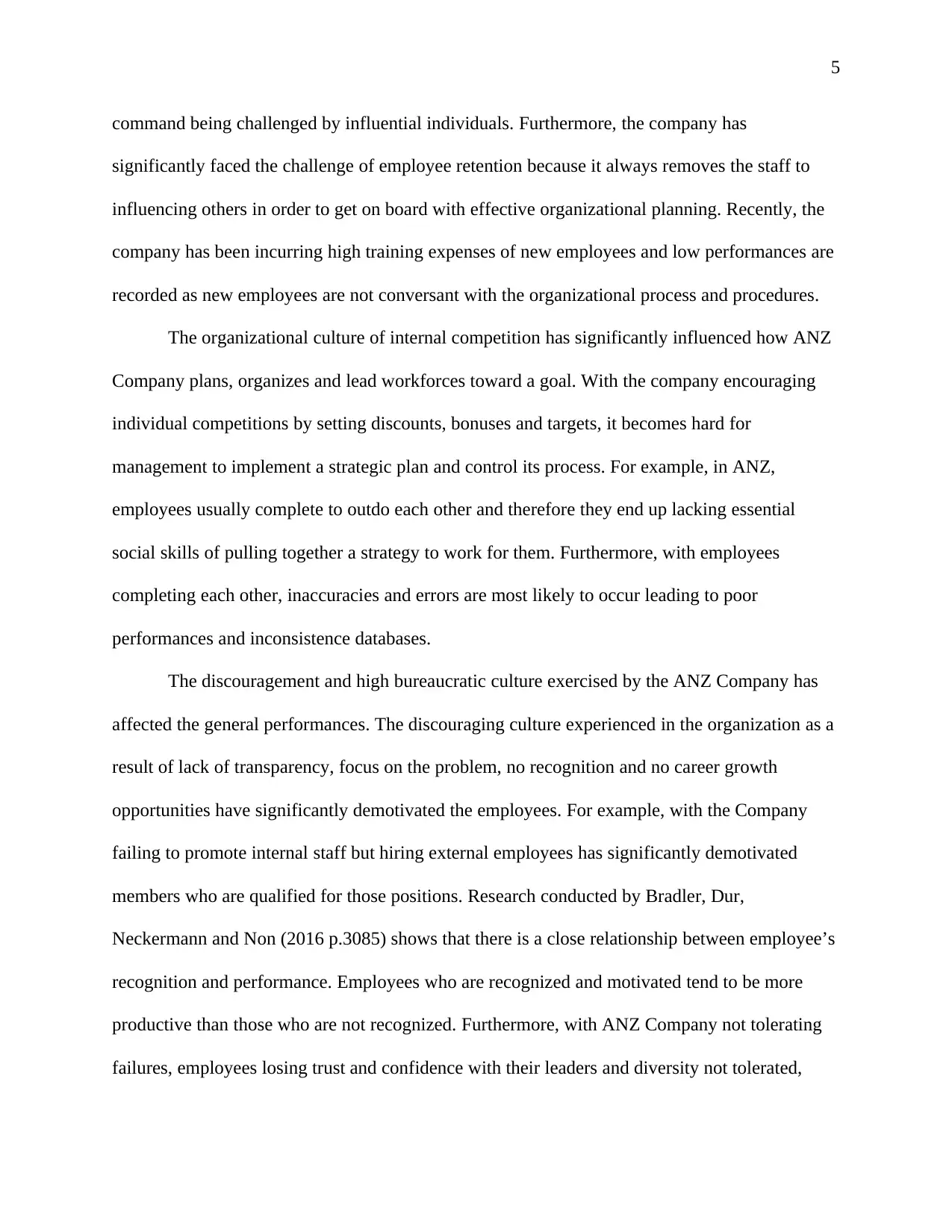
5
command being challenged by influential individuals. Furthermore, the company has
significantly faced the challenge of employee retention because it always removes the staff to
influencing others in order to get on board with effective organizational planning. Recently, the
company has been incurring high training expenses of new employees and low performances are
recorded as new employees are not conversant with the organizational process and procedures.
The organizational culture of internal competition has significantly influenced how ANZ
Company plans, organizes and lead workforces toward a goal. With the company encouraging
individual competitions by setting discounts, bonuses and targets, it becomes hard for
management to implement a strategic plan and control its process. For example, in ANZ,
employees usually complete to outdo each other and therefore they end up lacking essential
social skills of pulling together a strategy to work for them. Furthermore, with employees
completing each other, inaccuracies and errors are most likely to occur leading to poor
performances and inconsistence databases.
The discouragement and high bureaucratic culture exercised by the ANZ Company has
affected the general performances. The discouraging culture experienced in the organization as a
result of lack of transparency, focus on the problem, no recognition and no career growth
opportunities have significantly demotivated the employees. For example, with the Company
failing to promote internal staff but hiring external employees has significantly demotivated
members who are qualified for those positions. Research conducted by Bradler, Dur,
Neckermann and Non (2016 p.3085) shows that there is a close relationship between employee’s
recognition and performance. Employees who are recognized and motivated tend to be more
productive than those who are not recognized. Furthermore, with ANZ Company not tolerating
failures, employees losing trust and confidence with their leaders and diversity not tolerated,
command being challenged by influential individuals. Furthermore, the company has
significantly faced the challenge of employee retention because it always removes the staff to
influencing others in order to get on board with effective organizational planning. Recently, the
company has been incurring high training expenses of new employees and low performances are
recorded as new employees are not conversant with the organizational process and procedures.
The organizational culture of internal competition has significantly influenced how ANZ
Company plans, organizes and lead workforces toward a goal. With the company encouraging
individual competitions by setting discounts, bonuses and targets, it becomes hard for
management to implement a strategic plan and control its process. For example, in ANZ,
employees usually complete to outdo each other and therefore they end up lacking essential
social skills of pulling together a strategy to work for them. Furthermore, with employees
completing each other, inaccuracies and errors are most likely to occur leading to poor
performances and inconsistence databases.
The discouragement and high bureaucratic culture exercised by the ANZ Company has
affected the general performances. The discouraging culture experienced in the organization as a
result of lack of transparency, focus on the problem, no recognition and no career growth
opportunities have significantly demotivated the employees. For example, with the Company
failing to promote internal staff but hiring external employees has significantly demotivated
members who are qualified for those positions. Research conducted by Bradler, Dur,
Neckermann and Non (2016 p.3085) shows that there is a close relationship between employee’s
recognition and performance. Employees who are recognized and motivated tend to be more
productive than those who are not recognized. Furthermore, with ANZ Company not tolerating
failures, employees losing trust and confidence with their leaders and diversity not tolerated,
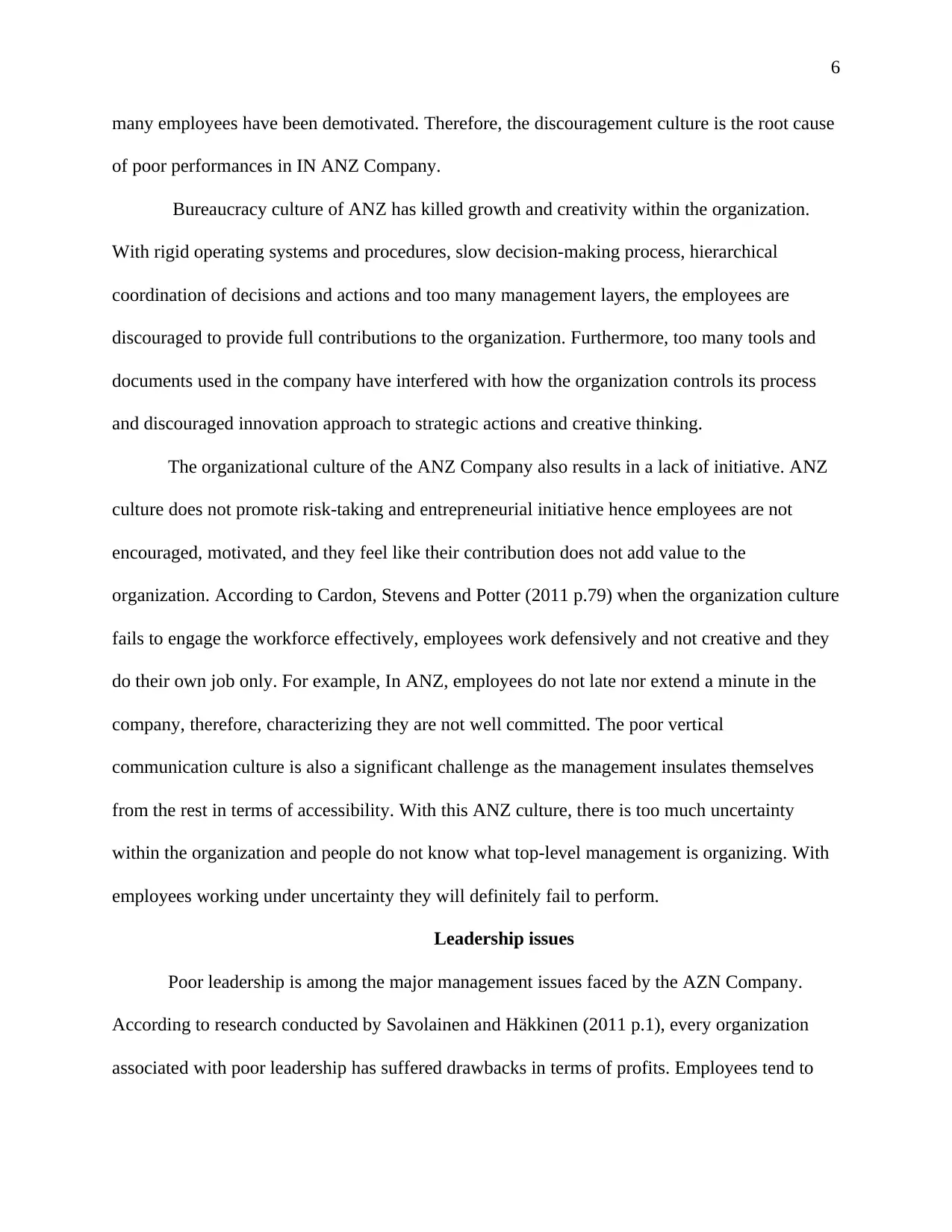
6
many employees have been demotivated. Therefore, the discouragement culture is the root cause
of poor performances in IN ANZ Company.
Bureaucracy culture of ANZ has killed growth and creativity within the organization.
With rigid operating systems and procedures, slow decision-making process, hierarchical
coordination of decisions and actions and too many management layers, the employees are
discouraged to provide full contributions to the organization. Furthermore, too many tools and
documents used in the company have interfered with how the organization controls its process
and discouraged innovation approach to strategic actions and creative thinking.
The organizational culture of the ANZ Company also results in a lack of initiative. ANZ
culture does not promote risk-taking and entrepreneurial initiative hence employees are not
encouraged, motivated, and they feel like their contribution does not add value to the
organization. According to Cardon, Stevens and Potter (2011 p.79) when the organization culture
fails to engage the workforce effectively, employees work defensively and not creative and they
do their own job only. For example, In ANZ, employees do not late nor extend a minute in the
company, therefore, characterizing they are not well committed. The poor vertical
communication culture is also a significant challenge as the management insulates themselves
from the rest in terms of accessibility. With this ANZ culture, there is too much uncertainty
within the organization and people do not know what top-level management is organizing. With
employees working under uncertainty they will definitely fail to perform.
Leadership issues
Poor leadership is among the major management issues faced by the AZN Company.
According to research conducted by Savolainen and Häkkinen (2011 p.1), every organization
associated with poor leadership has suffered drawbacks in terms of profits. Employees tend to
many employees have been demotivated. Therefore, the discouragement culture is the root cause
of poor performances in IN ANZ Company.
Bureaucracy culture of ANZ has killed growth and creativity within the organization.
With rigid operating systems and procedures, slow decision-making process, hierarchical
coordination of decisions and actions and too many management layers, the employees are
discouraged to provide full contributions to the organization. Furthermore, too many tools and
documents used in the company have interfered with how the organization controls its process
and discouraged innovation approach to strategic actions and creative thinking.
The organizational culture of the ANZ Company also results in a lack of initiative. ANZ
culture does not promote risk-taking and entrepreneurial initiative hence employees are not
encouraged, motivated, and they feel like their contribution does not add value to the
organization. According to Cardon, Stevens and Potter (2011 p.79) when the organization culture
fails to engage the workforce effectively, employees work defensively and not creative and they
do their own job only. For example, In ANZ, employees do not late nor extend a minute in the
company, therefore, characterizing they are not well committed. The poor vertical
communication culture is also a significant challenge as the management insulates themselves
from the rest in terms of accessibility. With this ANZ culture, there is too much uncertainty
within the organization and people do not know what top-level management is organizing. With
employees working under uncertainty they will definitely fail to perform.
Leadership issues
Poor leadership is among the major management issues faced by the AZN Company.
According to research conducted by Savolainen and Häkkinen (2011 p.1), every organization
associated with poor leadership has suffered drawbacks in terms of profits. Employees tend to
⊘ This is a preview!⊘
Do you want full access?
Subscribe today to unlock all pages.

Trusted by 1+ million students worldwide

7
lose motivation when they work under poor leadership that in turn translates to low productivity.
With poor leadership in diverse departments within ANZ Company, the staff is no longer taking
the initiative to hit their targets. For example, sales departments have recorded poor
performances for the last two years ever since the new leader was introduced into the
department. The manager has reported the inabilities of staff to hit their set daily targets for
unknown reasons. Furthermore, there are negative comments coming from the department with
employees complaining of harassments, threats and poor leadership. Therefore, when employees
lose trust with their leader they result to a minimal commitment to their takes and low motivation
to innovate and add new ideas that will be beneficial to the company which in turn results to poor
performances.
With AZN Company experiencing poor leadership, the staff members are not fully
utilized in the organization resulting in poor performances. The leadership style that is applied in
the organization is the transformation style that tends to limit the powers of leaders towards
proper maximization of the staff. For example, when an employee fails to hit the target in AZN
company, no actions are taken against him or her apart from several warnings and
encouragements. Furthermore, the employees have developed an attitude of underperforming as
they are aware that failing to hit the targets cannot make them lose their jobs. In addition, the
leaders also lack a capacity to evaluate weaknesses and strengths of employees and therefore the
end up assigning roles that do not bring employees strengths which is a key determinant of how
employees perform.
lose motivation when they work under poor leadership that in turn translates to low productivity.
With poor leadership in diverse departments within ANZ Company, the staff is no longer taking
the initiative to hit their targets. For example, sales departments have recorded poor
performances for the last two years ever since the new leader was introduced into the
department. The manager has reported the inabilities of staff to hit their set daily targets for
unknown reasons. Furthermore, there are negative comments coming from the department with
employees complaining of harassments, threats and poor leadership. Therefore, when employees
lose trust with their leader they result to a minimal commitment to their takes and low motivation
to innovate and add new ideas that will be beneficial to the company which in turn results to poor
performances.
With AZN Company experiencing poor leadership, the staff members are not fully
utilized in the organization resulting in poor performances. The leadership style that is applied in
the organization is the transformation style that tends to limit the powers of leaders towards
proper maximization of the staff. For example, when an employee fails to hit the target in AZN
company, no actions are taken against him or her apart from several warnings and
encouragements. Furthermore, the employees have developed an attitude of underperforming as
they are aware that failing to hit the targets cannot make them lose their jobs. In addition, the
leaders also lack a capacity to evaluate weaknesses and strengths of employees and therefore the
end up assigning roles that do not bring employees strengths which is a key determinant of how
employees perform.
Paraphrase This Document
Need a fresh take? Get an instant paraphrase of this document with our AI Paraphraser
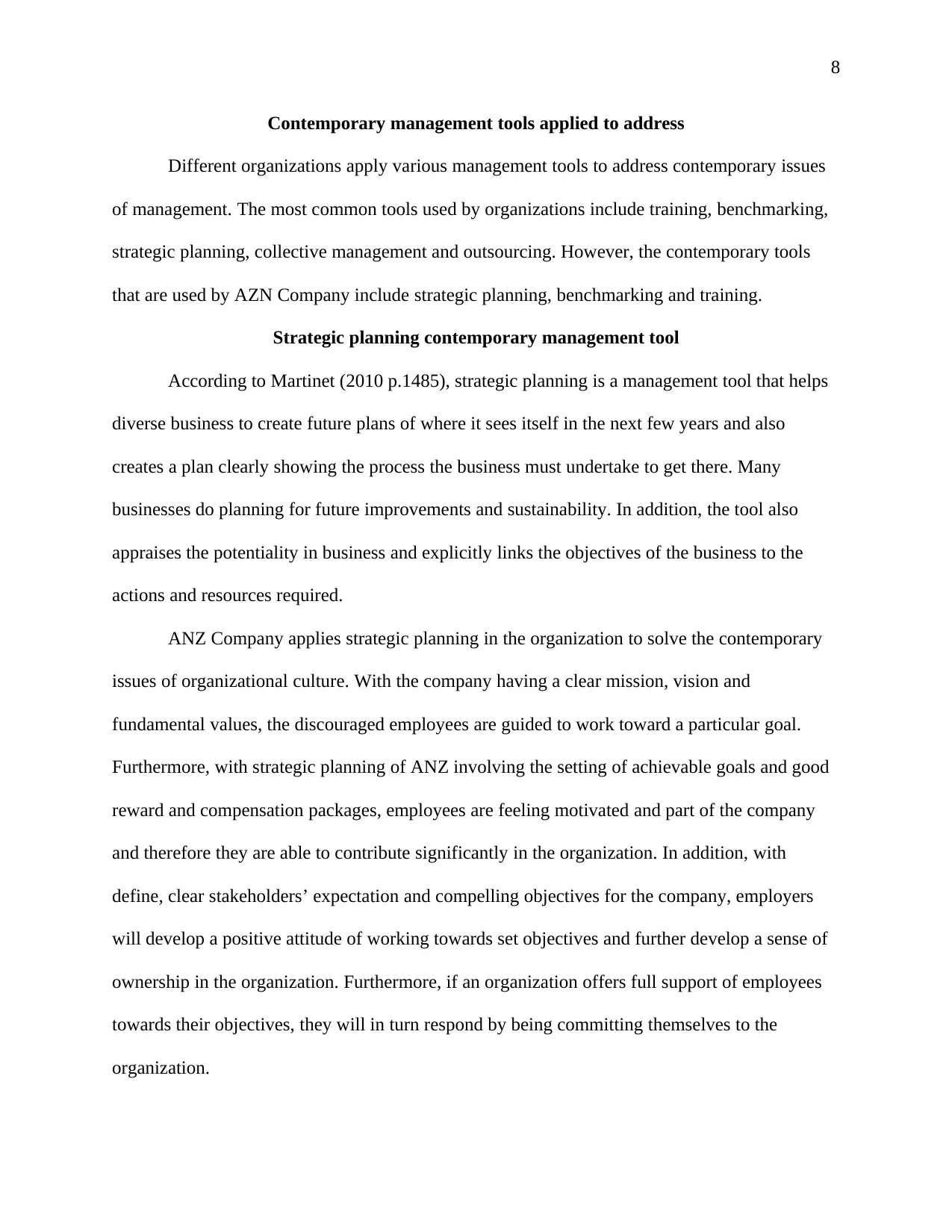
8
Contemporary management tools applied to address
Different organizations apply various management tools to address contemporary issues
of management. The most common tools used by organizations include training, benchmarking,
strategic planning, collective management and outsourcing. However, the contemporary tools
that are used by AZN Company include strategic planning, benchmarking and training.
Strategic planning contemporary management tool
According to Martinet (2010 p.1485), strategic planning is a management tool that helps
diverse business to create future plans of where it sees itself in the next few years and also
creates a plan clearly showing the process the business must undertake to get there. Many
businesses do planning for future improvements and sustainability. In addition, the tool also
appraises the potentiality in business and explicitly links the objectives of the business to the
actions and resources required.
ANZ Company applies strategic planning in the organization to solve the contemporary
issues of organizational culture. With the company having a clear mission, vision and
fundamental values, the discouraged employees are guided to work toward a particular goal.
Furthermore, with strategic planning of ANZ involving the setting of achievable goals and good
reward and compensation packages, employees are feeling motivated and part of the company
and therefore they are able to contribute significantly in the organization. In addition, with
define, clear stakeholders’ expectation and compelling objectives for the company, employers
will develop a positive attitude of working towards set objectives and further develop a sense of
ownership in the organization. Furthermore, if an organization offers full support of employees
towards their objectives, they will in turn respond by being committing themselves to the
organization.
Contemporary management tools applied to address
Different organizations apply various management tools to address contemporary issues
of management. The most common tools used by organizations include training, benchmarking,
strategic planning, collective management and outsourcing. However, the contemporary tools
that are used by AZN Company include strategic planning, benchmarking and training.
Strategic planning contemporary management tool
According to Martinet (2010 p.1485), strategic planning is a management tool that helps
diverse business to create future plans of where it sees itself in the next few years and also
creates a plan clearly showing the process the business must undertake to get there. Many
businesses do planning for future improvements and sustainability. In addition, the tool also
appraises the potentiality in business and explicitly links the objectives of the business to the
actions and resources required.
ANZ Company applies strategic planning in the organization to solve the contemporary
issues of organizational culture. With the company having a clear mission, vision and
fundamental values, the discouraged employees are guided to work toward a particular goal.
Furthermore, with strategic planning of ANZ involving the setting of achievable goals and good
reward and compensation packages, employees are feeling motivated and part of the company
and therefore they are able to contribute significantly in the organization. In addition, with
define, clear stakeholders’ expectation and compelling objectives for the company, employers
will develop a positive attitude of working towards set objectives and further develop a sense of
ownership in the organization. Furthermore, if an organization offers full support of employees
towards their objectives, they will in turn respond by being committing themselves to the
organization.
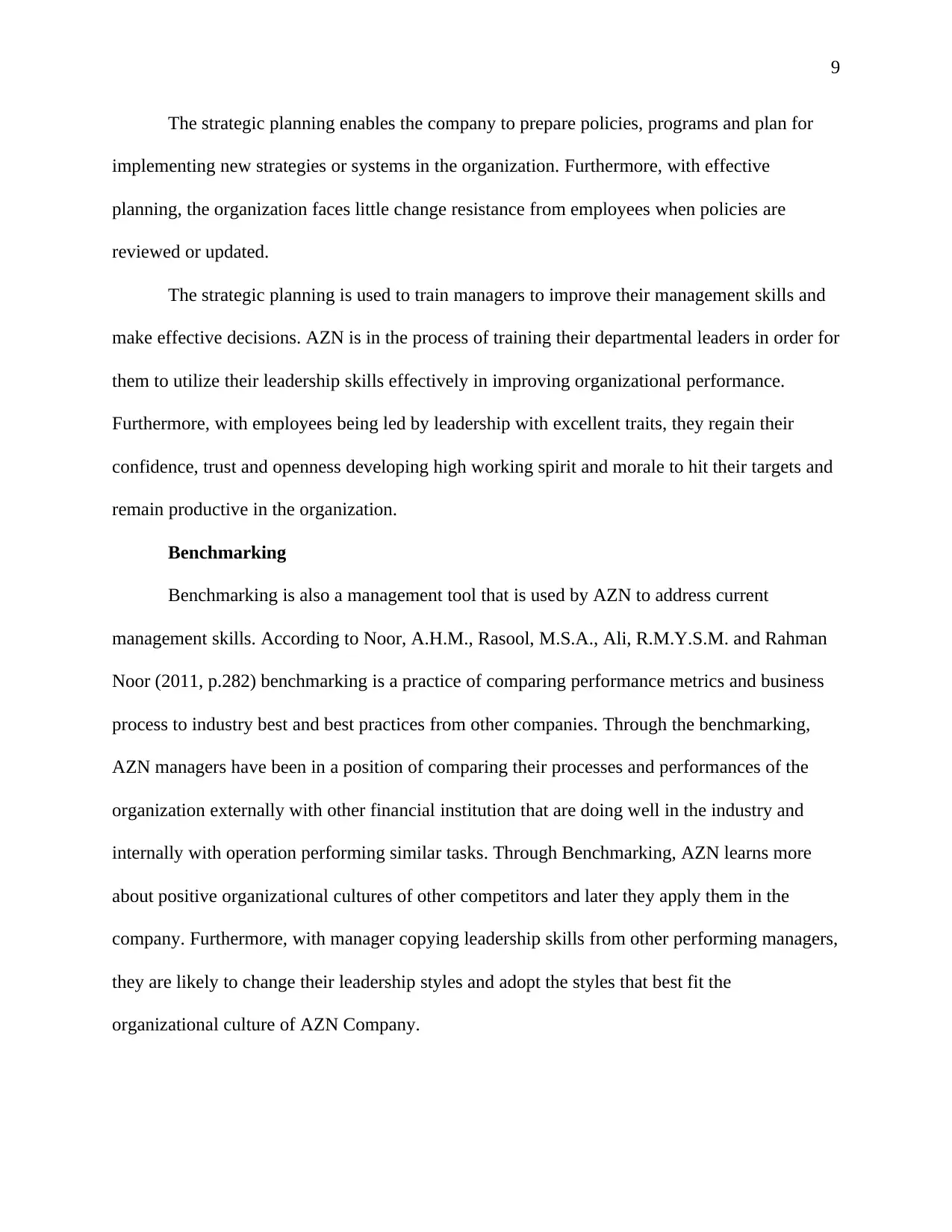
9
The strategic planning enables the company to prepare policies, programs and plan for
implementing new strategies or systems in the organization. Furthermore, with effective
planning, the organization faces little change resistance from employees when policies are
reviewed or updated.
The strategic planning is used to train managers to improve their management skills and
make effective decisions. AZN is in the process of training their departmental leaders in order for
them to utilize their leadership skills effectively in improving organizational performance.
Furthermore, with employees being led by leadership with excellent traits, they regain their
confidence, trust and openness developing high working spirit and morale to hit their targets and
remain productive in the organization.
Benchmarking
Benchmarking is also a management tool that is used by AZN to address current
management skills. According to Noor, A.H.M., Rasool, M.S.A., Ali, R.M.Y.S.M. and Rahman
Noor (2011, p.282) benchmarking is a practice of comparing performance metrics and business
process to industry best and best practices from other companies. Through the benchmarking,
AZN managers have been in a position of comparing their processes and performances of the
organization externally with other financial institution that are doing well in the industry and
internally with operation performing similar tasks. Through Benchmarking, AZN learns more
about positive organizational cultures of other competitors and later they apply them in the
company. Furthermore, with manager copying leadership skills from other performing managers,
they are likely to change their leadership styles and adopt the styles that best fit the
organizational culture of AZN Company.
The strategic planning enables the company to prepare policies, programs and plan for
implementing new strategies or systems in the organization. Furthermore, with effective
planning, the organization faces little change resistance from employees when policies are
reviewed or updated.
The strategic planning is used to train managers to improve their management skills and
make effective decisions. AZN is in the process of training their departmental leaders in order for
them to utilize their leadership skills effectively in improving organizational performance.
Furthermore, with employees being led by leadership with excellent traits, they regain their
confidence, trust and openness developing high working spirit and morale to hit their targets and
remain productive in the organization.
Benchmarking
Benchmarking is also a management tool that is used by AZN to address current
management skills. According to Noor, A.H.M., Rasool, M.S.A., Ali, R.M.Y.S.M. and Rahman
Noor (2011, p.282) benchmarking is a practice of comparing performance metrics and business
process to industry best and best practices from other companies. Through the benchmarking,
AZN managers have been in a position of comparing their processes and performances of the
organization externally with other financial institution that are doing well in the industry and
internally with operation performing similar tasks. Through Benchmarking, AZN learns more
about positive organizational cultures of other competitors and later they apply them in the
company. Furthermore, with manager copying leadership skills from other performing managers,
they are likely to change their leadership styles and adopt the styles that best fit the
organizational culture of AZN Company.
⊘ This is a preview!⊘
Do you want full access?
Subscribe today to unlock all pages.

Trusted by 1+ million students worldwide
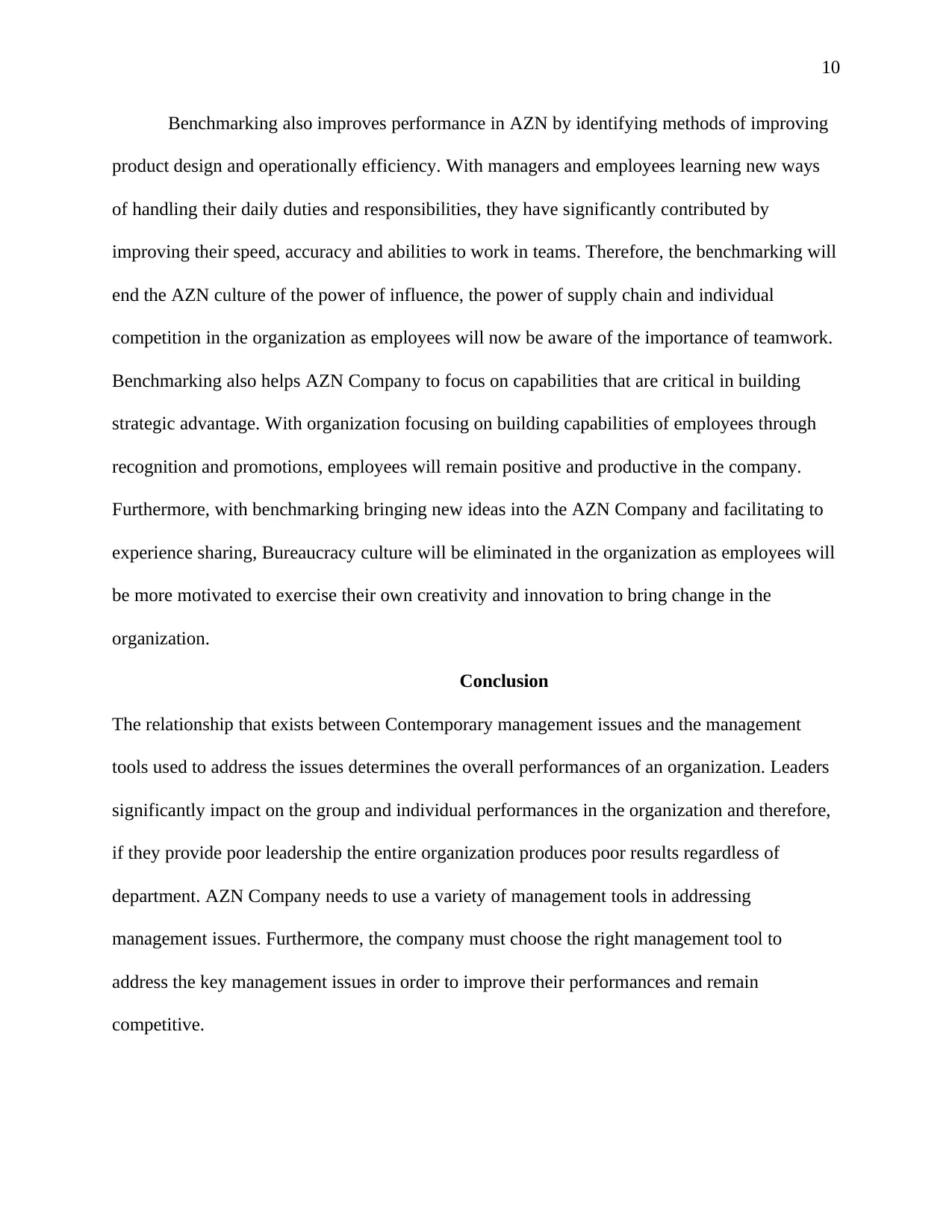
10
Benchmarking also improves performance in AZN by identifying methods of improving
product design and operationally efficiency. With managers and employees learning new ways
of handling their daily duties and responsibilities, they have significantly contributed by
improving their speed, accuracy and abilities to work in teams. Therefore, the benchmarking will
end the AZN culture of the power of influence, the power of supply chain and individual
competition in the organization as employees will now be aware of the importance of teamwork.
Benchmarking also helps AZN Company to focus on capabilities that are critical in building
strategic advantage. With organization focusing on building capabilities of employees through
recognition and promotions, employees will remain positive and productive in the company.
Furthermore, with benchmarking bringing new ideas into the AZN Company and facilitating to
experience sharing, Bureaucracy culture will be eliminated in the organization as employees will
be more motivated to exercise their own creativity and innovation to bring change in the
organization.
Conclusion
The relationship that exists between Contemporary management issues and the management
tools used to address the issues determines the overall performances of an organization. Leaders
significantly impact on the group and individual performances in the organization and therefore,
if they provide poor leadership the entire organization produces poor results regardless of
department. AZN Company needs to use a variety of management tools in addressing
management issues. Furthermore, the company must choose the right management tool to
address the key management issues in order to improve their performances and remain
competitive.
Benchmarking also improves performance in AZN by identifying methods of improving
product design and operationally efficiency. With managers and employees learning new ways
of handling their daily duties and responsibilities, they have significantly contributed by
improving their speed, accuracy and abilities to work in teams. Therefore, the benchmarking will
end the AZN culture of the power of influence, the power of supply chain and individual
competition in the organization as employees will now be aware of the importance of teamwork.
Benchmarking also helps AZN Company to focus on capabilities that are critical in building
strategic advantage. With organization focusing on building capabilities of employees through
recognition and promotions, employees will remain positive and productive in the company.
Furthermore, with benchmarking bringing new ideas into the AZN Company and facilitating to
experience sharing, Bureaucracy culture will be eliminated in the organization as employees will
be more motivated to exercise their own creativity and innovation to bring change in the
organization.
Conclusion
The relationship that exists between Contemporary management issues and the management
tools used to address the issues determines the overall performances of an organization. Leaders
significantly impact on the group and individual performances in the organization and therefore,
if they provide poor leadership the entire organization produces poor results regardless of
department. AZN Company needs to use a variety of management tools in addressing
management issues. Furthermore, the company must choose the right management tool to
address the key management issues in order to improve their performances and remain
competitive.
Paraphrase This Document
Need a fresh take? Get an instant paraphrase of this document with our AI Paraphraser
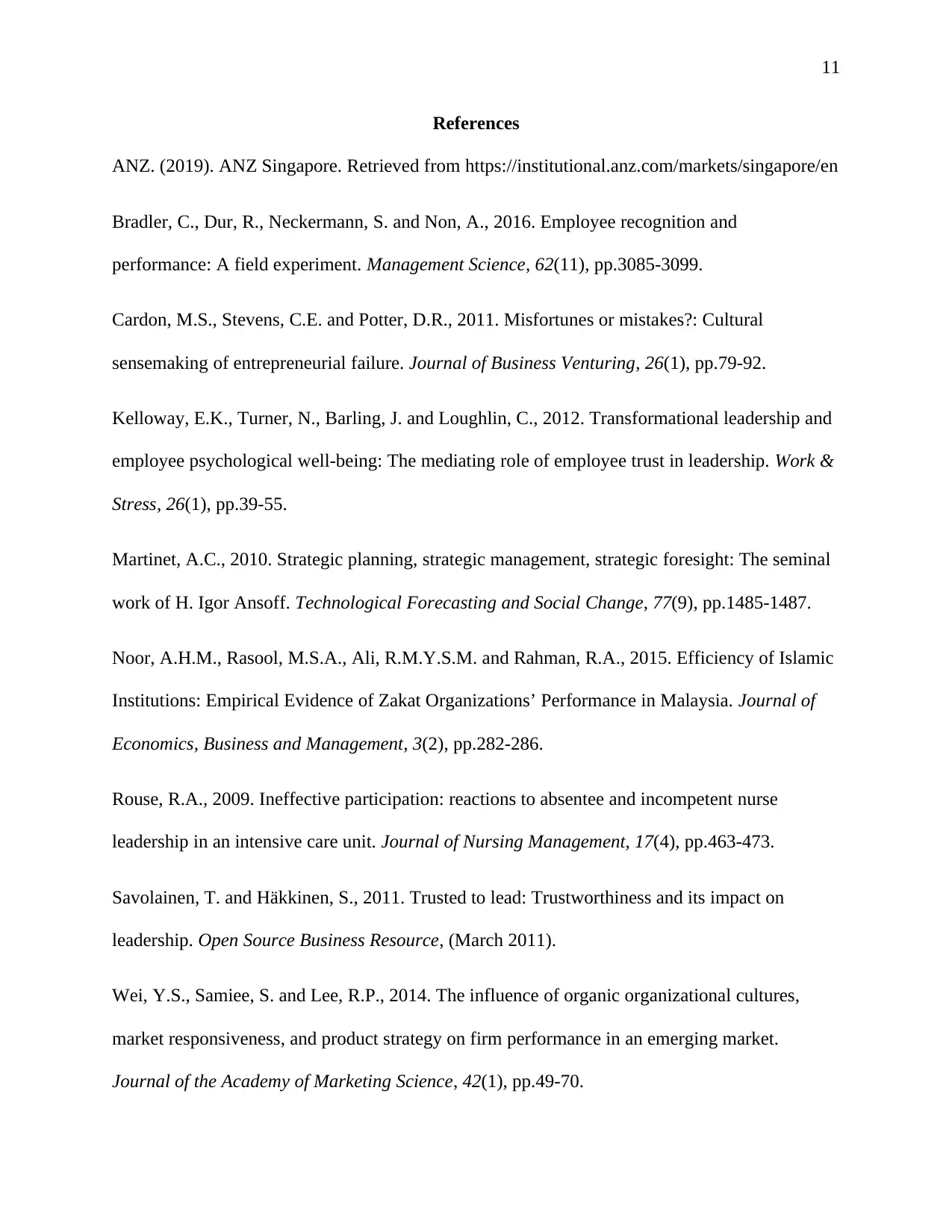
11
References
ANZ. (2019). ANZ Singapore. Retrieved from https://institutional.anz.com/markets/singapore/en
Bradler, C., Dur, R., Neckermann, S. and Non, A., 2016. Employee recognition and
performance: A field experiment. Management Science, 62(11), pp.3085-3099.
Cardon, M.S., Stevens, C.E. and Potter, D.R., 2011. Misfortunes or mistakes?: Cultural
sensemaking of entrepreneurial failure. Journal of Business Venturing, 26(1), pp.79-92.
Kelloway, E.K., Turner, N., Barling, J. and Loughlin, C., 2012. Transformational leadership and
employee psychological well-being: The mediating role of employee trust in leadership. Work &
Stress, 26(1), pp.39-55.
Martinet, A.C., 2010. Strategic planning, strategic management, strategic foresight: The seminal
work of H. Igor Ansoff. Technological Forecasting and Social Change, 77(9), pp.1485-1487.
Noor, A.H.M., Rasool, M.S.A., Ali, R.M.Y.S.M. and Rahman, R.A., 2015. Efficiency of Islamic
Institutions: Empirical Evidence of Zakat Organizations’ Performance in Malaysia. Journal of
Economics, Business and Management, 3(2), pp.282-286.
Rouse, R.A., 2009. Ineffective participation: reactions to absentee and incompetent nurse
leadership in an intensive care unit. Journal of Nursing Management, 17(4), pp.463-473.
Savolainen, T. and Häkkinen, S., 2011. Trusted to lead: Trustworthiness and its impact on
leadership. Open Source Business Resource, (March 2011).
Wei, Y.S., Samiee, S. and Lee, R.P., 2014. The influence of organic organizational cultures,
market responsiveness, and product strategy on firm performance in an emerging market.
Journal of the Academy of Marketing Science, 42(1), pp.49-70.
References
ANZ. (2019). ANZ Singapore. Retrieved from https://institutional.anz.com/markets/singapore/en
Bradler, C., Dur, R., Neckermann, S. and Non, A., 2016. Employee recognition and
performance: A field experiment. Management Science, 62(11), pp.3085-3099.
Cardon, M.S., Stevens, C.E. and Potter, D.R., 2011. Misfortunes or mistakes?: Cultural
sensemaking of entrepreneurial failure. Journal of Business Venturing, 26(1), pp.79-92.
Kelloway, E.K., Turner, N., Barling, J. and Loughlin, C., 2012. Transformational leadership and
employee psychological well-being: The mediating role of employee trust in leadership. Work &
Stress, 26(1), pp.39-55.
Martinet, A.C., 2010. Strategic planning, strategic management, strategic foresight: The seminal
work of H. Igor Ansoff. Technological Forecasting and Social Change, 77(9), pp.1485-1487.
Noor, A.H.M., Rasool, M.S.A., Ali, R.M.Y.S.M. and Rahman, R.A., 2015. Efficiency of Islamic
Institutions: Empirical Evidence of Zakat Organizations’ Performance in Malaysia. Journal of
Economics, Business and Management, 3(2), pp.282-286.
Rouse, R.A., 2009. Ineffective participation: reactions to absentee and incompetent nurse
leadership in an intensive care unit. Journal of Nursing Management, 17(4), pp.463-473.
Savolainen, T. and Häkkinen, S., 2011. Trusted to lead: Trustworthiness and its impact on
leadership. Open Source Business Resource, (March 2011).
Wei, Y.S., Samiee, S. and Lee, R.P., 2014. The influence of organic organizational cultures,
market responsiveness, and product strategy on firm performance in an emerging market.
Journal of the Academy of Marketing Science, 42(1), pp.49-70.

12
Weiss, E. and Coll, J.E., 2011. The influence of military culture and veteran worldviews on
mental health treatment: Practice implications for combat veteran help-seeking and wellness.
International Journal of Health, Wellness & Society, 1(2), pp.75-86.
Weiss, E. and Coll, J.E., 2011. The influence of military culture and veteran worldviews on
mental health treatment: Practice implications for combat veteran help-seeking and wellness.
International Journal of Health, Wellness & Society, 1(2), pp.75-86.
⊘ This is a preview!⊘
Do you want full access?
Subscribe today to unlock all pages.

Trusted by 1+ million students worldwide
1 out of 12
Related Documents
Your All-in-One AI-Powered Toolkit for Academic Success.
+13062052269
info@desklib.com
Available 24*7 on WhatsApp / Email
![[object Object]](/_next/static/media/star-bottom.7253800d.svg)
Unlock your academic potential
Copyright © 2020–2025 A2Z Services. All Rights Reserved. Developed and managed by ZUCOL.





